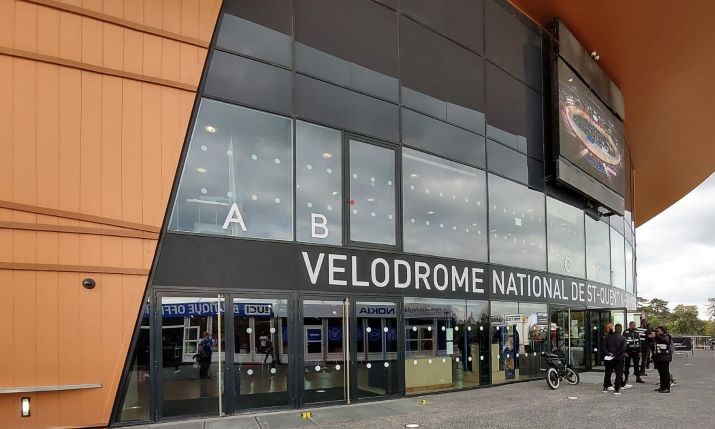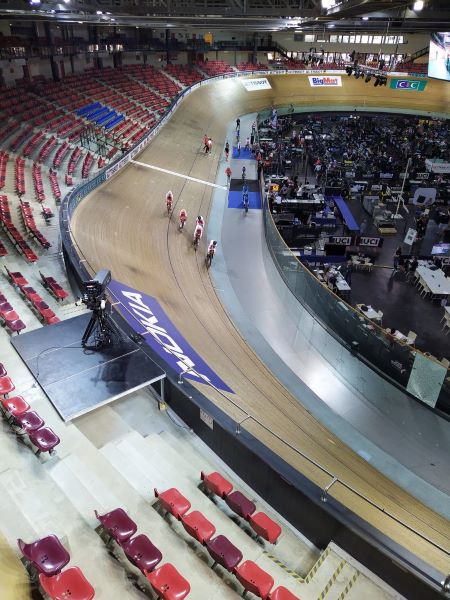Nokia launches 5G immersive stadium experience for UCI Track World Championships in run up to Paris 2024

Nokia rolled out a permanent 5G network at the Saint-Quentin-en-Yvelines National Velodrome for the 2022 UCI Track World Championships and as part of the French government 5G Stadium Lab programme, looking ahead also to Paris 2024
Telecoms network infrastructure provider, Nokia, has deployed a permanent 5G modular private wireless (MPW) network at the Saint-Quentin-en-Yvelines National Velodrome, France for the UCI Track World Championships. The deployment is designed to illustrate how 5G private wireless can significantly enhance the customer stadium and media experience.
During the five day 2022 UCI Track World Championships, which were held from 12 to 16 October near Paris, enhanced viewing and entertainment experiences were offered to fans, athletes, organisers and broadcasters, in cooperation with UCI and Eurovision Sport for TV production.
This network implementation is a demonstrator for the International Olympic Committee (IOC) and its broadcast plans for Paris 2024, as well as raising the broadcasting game for cycling at the velodrome. Nokia deployed the network as part of its continued work to develop 5G use cases under the French government’s 5G Stadium Lab programme.
Stéphane Haulbert, head of partners in Europe at Nokia, said to SVG Europe: “This set up is to learn and having in mind [the 2024] Olympic Games, and to propose this type of service for all [the Olympic] sites across France. But not only, that; we also had a lot of people coming from other countries interested to use this technology in stadiums or arenas around the world.
“This was much more than just a trial because we were in live conditions,” Haulbert continued. “What we discussed with the French federation to arrange this event is also to have included the perspectives for the Olympic Games in Paris two years from now. This was an opportunity to have a live event where we have 5,000 people in the stadium plus about 60 team members also in place, [which gave us the opportunity] to create some noise interference; it’s really interesting to understand the behaviour of the network in such a crowded environment, from a radio perspective.”

Inside the Saint-Quentin-en-Yvelines National Velodrome for the UCI Track World Championships 2022
Broadcasters and fans
Nokia used both 5G mmWave and 5G cmWave to show how they deliver extreme capacity, ultra low latency and ultra-high throughput to meet the diverse demands of many stakeholders – spectators, sponsors, medias. Beyond the immersive experience, robust private wireless networks also support video and data sharing to improve situational awareness in the stadium for security and safety teams.
Said Haulbert: “We use the two types of frequency for this event to meet some requirements of the different needs for broadcasting and the final experience. The millimetre wave is 26GHz frequency; it’s very high bandwidth. The higher you are [in the spectrum], the more bandwidth you have and [therefore] more throughput for high quality video.
“For this demonstration we used 4K but also an 8K camera with 360 view. The more cameras you put on high resolution, you need more bandwidth and this is a benefit of this 5G millimetre wave we brought in on this trial.”
The network is a dedicated, permanent network. Noted Haulbert: “It’s quite compact because we deployed only four base stations for this purpose, two for each of the different bands we used for this purpose.”
Live video streams of UCI Track World Championships races were shown on a large screen at the Nokia booth. Visitors were able to tailor their view of the action, thanks to 360° robotic cameras at the velodrome operated remotely in real time. Using 5G smartphones, tablets and headsets, they were able to access multiscreen views and race statistics in augmented reality (AR) as well as hear the sounds of the track, the atmosphere in the stadium or audio commentary in the language of their choice.
XD Motion also contributed to the trial, working with Nokia and mobile operator partner, Orange, along with other partners. All XD motion specialty cameras were remotely controlled in 5G ultra low latency by 5G bandwidth over public, private N77 and 5G mmWave on 26Ghz.
Success and learnings
Haulbert commented on the first run for the network: “It was very successful, first on 26GHz we demonstrate that it’s the right one for very high quality video with no interference. When we use a bandwidth close to the service provider’s one we didn’t have interference or problems with the bandwidth or with others, with mobile network operators.”
However, he added: “The challenge was much more with Wi-Fi, because the teams coming from all around the world provided some Wi-Fi equipment that created some interference, so we have had to explain to the teams, to UCI and the International Federation for Cycling and also for the organisation team for the Olympic Games, how they need to educate people to use spectrum. So from a demonstration of 5G capability perspective, was very successful and we know that it works well.”
As a telecom’s infrastructure provider, Haulbert gave his opinion on the future potential for 5G in sports broadcasting: “”What I say to people on 5G is maybe there is almost no limit on what you can do with it. The question is not what I can do with 5G; let me know what you want to do [the broadcaster], and I believe we can do it.
“Here there is no prototype in this demonstration; it’s a social project that we have commercialised with our partner. Every day we can address the way we are engineering the network, and from a future perspective you have everything you can use to set up these private events and manage them for the organisation. There isn’t any limit on the imagination of broadcasters.”
Haulbert concluded: “The work we are doing with industry partners under the 5G Stadium Lab allows us to develop and test in-demand use cases for services such as security, leveraging artificial intelligence (AI) and machine learning capabilities to enable, for example automated monitoring of multiple video and sensor data feeds and alerts. Private wireless puts the network owner in control, allowing them to support the distinct needs of a variety of stakeholders and services.”
Nokia also showed how 5G private wireless networks can support other stakeholders, such as media photographers, who were able to upload images during the event in an instant.
Under the 5G Stadium Lab programme, Nokia will continue its work with industry partners to develop compelling Industry 4.0 use cases for use at future sporting events.
